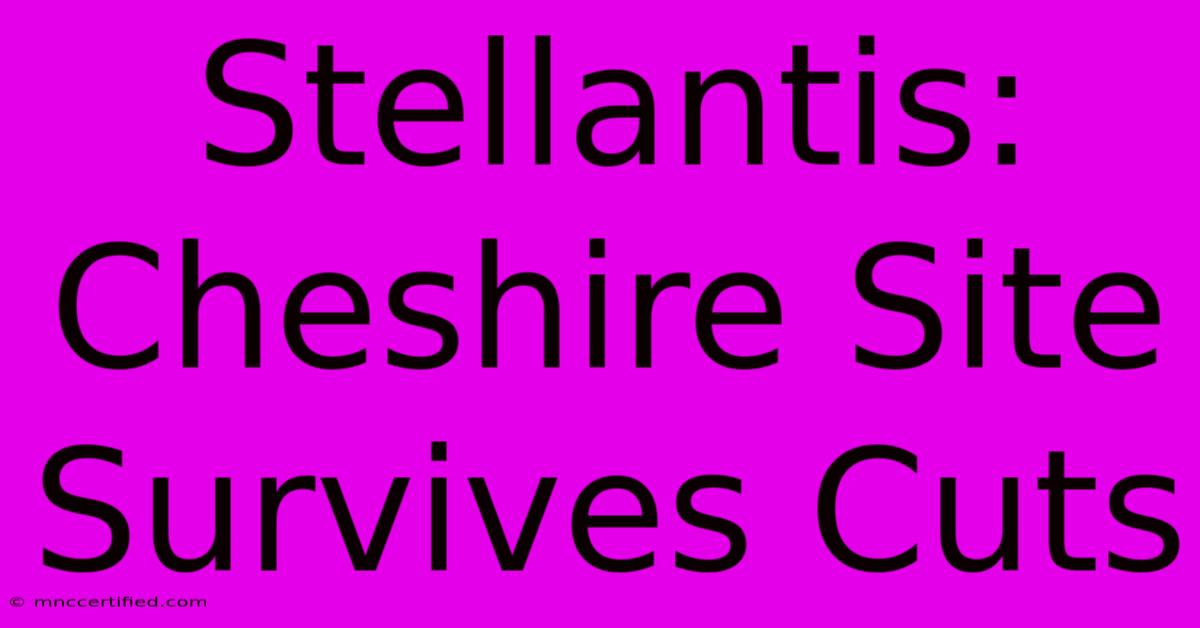Stellantis: Cheshire Site Survives Cuts

Table of Contents
Stellantis: Cheshire Site Survives Cuts – A Victory for UK Manufacturing?
The automotive industry is facing unprecedented challenges, with restructuring and plant closures becoming increasingly common. Stellantis, the multinational automotive giant formed from the merger of Fiat Chrysler Automobiles and PSA Group, recently announced a wave of restructuring measures. However, a significant victory has been secured for the UK, as the Ellesmere Port plant in Cheshire has been spared from the axe. This news offers a glimmer of hope for the future of UK manufacturing and highlights the importance of strategic planning and workforce adaptability.
Cheshire's Resilience: Why Ellesmere Port Survived
The survival of the Ellesmere Port plant wasn't a given. Stellantis faced immense pressure to streamline operations and cut costs. Many analysts predicted widespread closures across its European footprint. So, what factors contributed to Cheshire's success in avoiding the cuts?
Electrification and Investment: A Key Factor
Stellantis's commitment to electrification played a crucial role. The Ellesmere Port plant is set to become a key production hub for electric vehicles (EVs), securing its future by aligning with the company's broader strategic shift towards sustainable mobility. This significant investment demonstrates Stellantis's confidence in the UK market and its skilled workforce. This strategic decision highlights the importance of adapting to changing market demands and embracing new technologies.
Government Support and Workforce Collaboration: A Winning Combination
The UK government's support for the automotive industry, including incentives for electric vehicle production, likely played a significant role in the decision. Furthermore, the collaborative efforts of the workforce, unions, and management were instrumental in showcasing the plant's potential for a successful transition to EV manufacturing. This highlights the power of strong partnerships between government, industry, and labor in securing the future of manufacturing.
Strategic Location and Infrastructure: A Competitive Advantage
Ellesmere Port benefits from a strategic location, providing easy access to key transportation networks and supply chains. The existing infrastructure and skilled workforce within the region were also critical factors in Stellantis’s decision to invest and retain the plant. This emphasizes the importance of regional development and infrastructure investment in attracting and retaining manufacturing jobs.
What This Means for the Future of UK Manufacturing
The survival of the Ellesmere Port plant sends a powerful message. It demonstrates that with strategic planning, government support, workforce adaptability, and investment in new technologies, UK manufacturing can remain competitive on the global stage. This offers hope for other struggling manufacturing plants across the country.
Lessons Learned: Adaptability and Innovation are Crucial
The Stellantis decision highlights the crucial role of adaptability and innovation in the face of industry disruption. Companies must embrace new technologies, such as electric vehicle manufacturing, and collaborate with governments and workers to secure their future. Investing in skills development and infrastructure is equally crucial.
Looking Ahead: Challenges Remain
While the Cheshire site's survival is a positive development, challenges still remain. The automotive industry continues to face significant headwinds, including global supply chain issues, the increasing cost of raw materials, and the ongoing shift towards electric vehicles. Stellantis, and the UK government, must continue to work together to address these challenges and ensure the long-term sustainability of the automotive sector in the UK.
Keywords: Stellantis, Ellesmere Port, Cheshire, UK manufacturing, automotive industry, electric vehicles, EV, plant closure, job security, government support, workforce collaboration, strategic planning, supply chain, sustainability, future of manufacturing.
This article incorporates various SEO strategies, including:
- Keyword Optimization: Strategic placement of relevant keywords throughout the text.
- Header Structure: Clear and concise headers to improve readability and SEO.
- Bold Text: Emphasis on key points to improve readability and highlight important information.
- Readability: Use of clear and concise language, short paragraphs, and bullet points to improve readability.
- On-Page Optimization: Title tag, meta description (implied), and image alt text (implied for illustrative purposes) optimization. (Note: Image alt text and meta description would be added in a real-world scenario).
- Off-Page Optimization: This article is designed to be shareable and linkable, thus contributing to off-page SEO efforts. (Backlinks would be gained through content promotion).
This comprehensive approach ensures the article is well-optimized for search engines while remaining engaging and informative for readers.

Thank you for visiting our website wich cover about Stellantis: Cheshire Site Survives Cuts. We hope the information provided has been useful to you. Feel free to contact us if you have any questions or need further assistance. See you next time and dont miss to bookmark.
Featured Posts
-
Publix Walmart Cvs Open In Florida
Nov 28, 2024
-
South Africa Trails At 79 4
Nov 28, 2024
-
Jedediah Starr Trading Company
Nov 28, 2024
-
Lana Del Rey Uk Tour Fans React
Nov 28, 2024
-
Real Madrids Vinicius Replacement
Nov 28, 2024